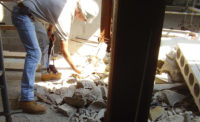Teamwork, collaboration and trust would prove just as critical as technical skill and logistical resourcefulness in reopening the Interstate 40/Hernando de Soto Bridge, closed in May 2021 following discovery of a cracked tie beam. An effort that began shrouded by multiple uncertainties quickly gave way to a successful stabilization and repair strategy that had traffic safely back on the key Mississippi River crossing between Tennessee and Arkansas in less than three months.
Chris Frieberg, vice president of operations and Tennessee area manager for Kiewit Infrastructure South Co., led the Kiewit team tapped for the emergency construction manager/general contractor project. He credits a multi-faceted collaboration that demanded the full commitment of engineers, consultants and two state transportation agencies for helping transform those initial challenges into viable solutions.
Related Article:
Analysis Traces Mississippi River Bridge Beam Crack to Fabrication
Back to:
25 Top Newsmakers
“The collaboration was there from the first phone call with the design and consultant team after we were selected,” Frieberg recalls. “Everyone understood the magnitude of the problem, as well as the key issues associated with the repair concepts and how the process would unfold.”
Still, time was of the essence to repair the crack, eventually traced to a weld defect that likely occurred during tie-beam fabrication.
By the end of the first week, Kiewit workers had stabilized the fracture area with a “splint” composed of 30,000 lb of structural steel plates. In phase two, a 150-ft-long section of tie girder encompassing the fracture area was beefed up with 108,000 lb of additional redundant plating. Eight 3-in.-dia high-strength post-tensioning rods installed alongside the beam transferred 1.2 million lb of tension to the composite section.

Throughout the process, it was up to Frieberg to keep the entire CMGC team pulling in the same direction, tackling myriad challenges from sourcing the needed fracture-critical steel to ensuring the tension transfer posed no risk to workers on the bridge.
Ted Kniazewycz, director of the Tennessee Dept. of Transportation’s structures division, calls Frieberg “a steady leader” who brought “an attitude of safety, innovation and teamwork to a very complex and critical infrastructure project.”
The final phase of the repair effort—reinforcing more than 40 similar weld anomalies to prevent the formation of new cracks—was completed in July, allowing the bridge to reopen just 83 days after the initial emergency shutdown.
Frieberg calls the experience stressful, but also educational. “It really opens your eyes to the responsibilities of each teammate in a CM/GC project—the contractor’s responsibility to carry out construction, the engineer’s responsibility to sign and seal the design and the owner’s responsibility for the long-term investment,” he says.
“It’s a project I’ll probably talk about the rest of my life,” he adds.




